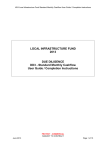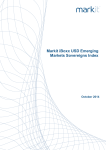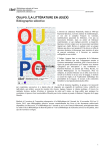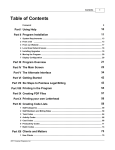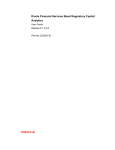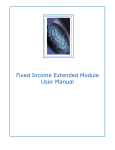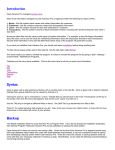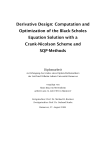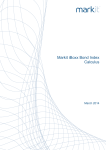Download User Guide
Transcript
Markit iBoxx European ABS Index Guide Version 1.1 October 2014 Markit iBoxx European ABS Index Guide Contents Changes to the Markit iBoxx European ABS Index................................................................................................... 3 1 Introduction .......................................................................................................................................................... 4 2 Structure of the index family .............................................................................................................................. 5 3 Selection Criteria .................................................................................................................................................. 6 3.1 Bond type ........................................................................................................................................................ 6 3.1.1 List of eligible bond types ....................................................................................................................... 6 3.1.2 List of ineligible bond types ..................................................................................................................... 6 3.2 Securitization type........................................................................................................................................... 6 3.2.1 Eligible securitization types ..................................................................................................................... 6 3.2.2 List of ineligible securitization types ........................................................................................................ 7 3.3 Issuer origin .................................................................................................................................................... 7 3.4 Credit rating .................................................................................................................................................... 7 3.5 Bond size and currency of issue ..................................................................................................................... 7 3.6 Market of issue................................................................................................................................................ 8 3.7 Availability of pricing ....................................................................................................................................... 8 4 Index rebalancing ................................................................................................................................................. 9 5 Data and index calculation ................................................................................................................................ 10 5.1 ABS bond prices ........................................................................................................................................... 10 5.2 Payment data ................................................................................................................................................ 10 5.2.1 Data source ........................................................................................................................................... 10 5.2.2 Treatment of late or corrected payment information ............................................................................. 10 5.3 FX data ......................................................................................................................................................... 11 5.4 Settlement convention .................................................................................................................................. 11 5.5 Index formulas .............................................................................................................................................. 11 5.5.1 Total Return Index (Single Currency) ................................................................................................... 11 5.5.2 Total Return Index Unhegded ............................................................................................................... 11 5.6 Treatment of certain intra-month events ....................................................................................................... 11 5.6.1 Treatment of redemption payments ...................................................................................................... 11 5.6.2 Reinvestment of coupons and redemption payments .......................................................................... 12 5.7 Index Restatement ........................................................................................................................................ 12 5.8 Index Review ................................................................................................................................................ 12 6 Analytics ............................................................................................................................................................. 13 6.1 Bond analytics............................................................................................................................................... 13 6.1.1 Base market value ................................................................................................................................ 13 6.1.2 Market value ......................................................................................................................................... 13 6.1.3 New cash payments.............................................................................................................................. 13 6.1.4 Cash payments ..................................................................................................................................... 13 6.2 Index analytics .............................................................................................................................................. 13 6.2.1 Base market value ................................................................................................................................ 13 6.2.2 Market value ......................................................................................................................................... 13 6.2.3 New cash payments.............................................................................................................................. 14 6.2.4 Cash payments ..................................................................................................................................... 14 6.2.5 Number of bonds .................................................................................................................................. 14 6.2.6 Month-to-date return ............................................................................................................................. 14 6.2.7 Year-to-date return................................................................................................................................ 14 7 Appendix ............................................................................................................................................................. 15 7.1 Index ratings ................................................................................................................................................. 15 7.2 Definition of the index fields: ......................................................................................................................... 16 7.3 Annotations ................................................................................................................................................... 16 8 Further Information ............................................................................................................................................ 17 9 Disclaimer ........................................................................................................................................................... 18 Copyright © 2014, Markit Group Limited. All rights reserved. www.markit.com 2 Markit iBoxx European ABS Index Guide Changes to the Markit iBoxx European ABS Index 01 Oct 2014 Index restatement, complaints sections added 01 Sept 2014 Index review Copyright © 2014, Markit Group Limited. All rights reserved. www.markit.com 3 Markit iBoxx European ABS Index Guide 1 Introduction Markit Indices is the leading global provider of benchmark and index services. Markit indices cover all asset classes including fixed income, credit, structured finance, equity and environmental. In addition to our Markit index families, we provide a range of index related services enable our clients to meet their specific custom or bespoke index requirements. Our indices are used by investment banks, asset managers, hedge funds, insurance companies for benchmarking, risk management, valuation and as the basis of a wide range of financial products including exchange traded funds, index funds, structured products and derivatives. Markit is a leading, global financial information services company with over 2,000 employees. The company provides independent data, valuations and trade processing across all asset classes in order to enhance transparency, reduce risk and improve operational efficiency. Its client base includes the most significant institutional participants in the financial marketplace. For more information, see www.markit.com The Markit iBoxx European ABS Index family is designed to measure the performance of EUR, GBP and USDdenominated asset-backed securities originating from Europe. The index family allows market participants to benchmark to indices with various asset class, rating, currency, and country of collateral profiles. Investors can measure the relative performance of their assets to the overall index or relevant sub-index. Researchers can gain a better understanding of the returns available from the European ABS market, and advisors and fund managers will obtain insight into the relative performance of this assets class against other fixed income markets. The Markit iBoxx European ABS Index is calculated by Markit on a daily basis based on prices provided by the Markit European ABS Pricing Service based on contributions from 20 market makers. This unique pricing methodology ensures accurate pricing of index constituent securities that is independent of any single broker dealer or pricing source. This document contains the selection rules and calculation methodology for the Markit iBoxx European ABS Index. Copyright © 2014, Markit Group Limited. All rights reserved. www.markit.com 4 Markit iBoxx European ABS Index Guide 2 Structure of the index family The index family comprises an overall index, and sub-indices by country, ABS sector, currency of issue, and rating; and combinations of the above. All indices are calculated in EUR, GBP and USD. Level 0 Level 1 Level 2 Level 3 Level 4 CMBS MBS RMBS Loan Obligations ABS Business ABS ABS ex-MBS Buy-to-Let RMBS Non-conforming RMBS Prime RMBS RMBS CLO SME CLO Equipment Lease Trade Receivables WBS Auto Retail ABS Excluding GRANM GRANM only Auto Lease Auto Loans Credit Card Student Loans Table 1: ABS sector structure Additional indices covering only bonds issued by Granite and indices excluding Granite bonds are calculated for Prime RMBS and the UK. Region Europe Western Europe UK Eastern Europe Country Austria Belgium Finland France Germany Greece Ireland Italy Netherlands Portugal Spain Denmark Norway Sweden Switzerland Russia Turkey Ukraine Multi-country Table 2: ABS geographical breakdown Copyright © 2014, Markit Group Limited. All rights reserved. www.markit.com 5 Markit iBoxx European ABS Index Guide Table 3: Seniority Breakdown Number Seniority Definition Senior Super senior A is normally senior unless specified, there is a priority of payment between series of A, then we consider Super Senior. Senior NonSenior NonSenior NonSenior Senior A is normally senior unless specified, there is a priority of payment between series of A, then we consider Super Senior. Subordinate B is normally Subordinate unless specified otherwise, sometimes Mezzanine Mezzanine M is normally Mezzanine unless specified otherwise, sometimes Subordinate Junior Junior is the last subordinate bond in the capital structure. 3 Selection Criteria A number of selection criteria are applied to the outstanding universe of European Asset-backed Securities to determine the index constituents list: Bond type Securitization type Issuer origin Credit rating Bond size and currency of issue Market of issue Availability of pricing and payment information 3.1 3.1.1 Bond type List of eligible bond types Floating-rate bonds Sinking funds and amortizing bonds Fixed-to-floater bonds (only after the switch to a floating rate coupon) Tap issues 3.1.2 List of ineligible bond types Fixed-rate bonds Fixed-to-floater bonds (during the fixed coupon period) 3.2 Securitization type The list of eligible ABS types is limited to standard ABS type in common in the market. Complex structures such as CDOs are not eligible. Only ABS issued by Special Purpose Vehicles (SPVs) are eligible for the index. 3.2.1 Eligible securitization types Auto Leases Auto Loans Commercial Mortgage-Backed Securities (CMBS) Residential Mortgage-Backed Securities (RMBS) Copyright © 2014, Markit Group Limited. All rights reserved. www.markit.com 6 Markit iBoxx European ABS Index Guide Buy-To-Let Residential Mortgage-Backed Securities ( BTL RMBS) Prime Residential Mortgage-Backed Securities (PRMBS) Non-conforming Residential Mortgage-Backed Securities (SPRMBS) Credit Cards Equipment Leases Insurance Premium Loans Balance sheet collateralized loan obligations* Small & Medium-size Enterprises (SME) Collateralized loan obligations Student loans Trade receivables Whole business securitizations *Balance sheet collateralized loan obligations are transactions distinguished by collateral that is originated by the same bank that is either selling the collateral into an SPV, or buying protection on the collateral. 3.2.2 List of ineligible securitization types Collateralized Debt Obligations (CDOs) Leveraged collateralized loan obligations 3.3 Issuer origin The originating entity needs to be domiciled in Europe. 3.4 Credit rating Bonds must be rated CCC or higher based on an average index rating determined by Markit. Please refer to the appendix (section 9.1) for details of the average rating calculation. Ratings issued by Fitch, Moody’s and Standard & Poor’s are considered. A constituent is removed from the index at the next rebalancing if its average index rating falls below CCC. 3.5 Bond size and currency of issue The currency of the bond must be EUR, GBP and USD-denominated and all payments need to be in the issue currency. At inclusion in the index, the minimum amount outstanding required for the index differs depending on the rating of the ABS: 500m local currency for originally AAA rated securities 30m local currency for securities originally rated AA and lower Bonds will remain in the index until paid down completely regardless of outstanding size, so long as each meets all other selection criteria. The amortization schedule of ABS lends to having a sometimes large portion of the market having low outstanding balances. Markit wishes to keep the index as representative of the market as possible by keeping smaller bonds in the index, noting that bonds are weighted in their respective indices by outstanding size. Bonds that had been excluded from index need to fulfil the full amount outstanding criterion in order to qualify for reinclusion. Copyright © 2014, Markit Group Limited. All rights reserved. www.markit.com 7 Markit iBoxx European ABS Index Guide 3.6 Market of issue Bonds issued via private placements are not eligible for the index. Public issues and private placements which have subsequently become publicly traded are eligible for the index. 3.7 Availability of pricing th Bonds are only eligible for the index if an updated price is available in the period starting from the 7 business day rd prior to month-end to the 3 last business day prior to month-end. Copyright © 2014, Markit Group Limited. All rights reserved. www.markit.com 8 Markit iBoxx European ABS Index Guide 4 Index rebalancing The index is rebalanced on the last calendar day of each month (“Rebalancing date”). The cut-off date for meeting the eligibility criteria is 3 business days prior to the rebalancing date. Newly issued bonds that have not settled three business days prior to the rebalancing date are only included in the index, if (a) they settle before the rebalancing date and (b) their rating and outstanding amount are known with certainty 3 business days prior to the rebalancing date, (c) pricing is available. 2 business days prior to the rebalancing date; the membership list with the final outstanding amounts for each bond will be published. On the last business day prior to the rebalancing date, Markit publishes the closing prices of all bonds in the final membership list, at the close of business. Copyright © 2014, Markit Group Limited. All rights reserved. www.markit.com 9 Markit iBoxx European ABS Index Guide 5 Data and index calculation The index is calculated and published on a daily basis, seven days a week, including market holidays. An index is calculated if there is at least one bond available that matches all inclusion criteria. If no more bonds qualify for an index, then its level will remain constant. If at least one bond becomes available again, the index calculation will be resumed from the last calculated level. The index history starts on 31 December 2006 at an index level of 100. 5.1 ABS bond prices The index calculation is based on bid prices. In the event that no bid price is available for a particular date, the last available bid price will be carried forward. This might be the case in periods of market stress, or disruption as well as in illiquid or fragmented markets. If the required inputs become impossible to obtain, the bond will become ineligible for the index – please refer to section 3.7. New bonds enter the index at their respective ask prices. Bid price quotes for bonds in the eligible universe are provided by Markit ABS Pricing Service. At launch the market makers providing bond prices to the Markit ABS Pricing Service are: Banco Santander Bank of America BNP Paribas Citigroup Deutsche Bank Goldman Sachs JP Morgan Lloyds Morgan Stanley Natixis Nomura Societe Generale Spread and Weighted average life are not used in the calculation of the index but are displayed as additional information. Bid spread quotes and weighted average life for bonds in the eligible universe are provided by Markit ABS Pricing Service. 5.2 5.2.1 Payment data Data source Cash flow payment information used for Markit iBoxx ABS indices is provided by Markit’s European Reference Cashflow Database (ERCD). ERCD incorporates validated payment data tranche by tranche directly from investor payment reports. Such data is used to track payments and shortfalls of interest and principal, as well as writedowns and writedown-reimbursements. 5.2.2 Treatment of late or corrected payment information Information about principal repayments and interest shortfalls may not be received until after the effective payment date. In such instances, the index assumes that all interest payments have been made in full and that no principal repayments have been made. The pool factor of the bond in the index remains unchanged. The information is updated on the first calculation date after the information has become available and the market value, cash and accrued interest of the bond in the index is adjusted going forward. For the avoidance of doubt – no information received is applied retroactively; this includes pool factors and accrued interest. Accrued interest is calculated daily based on the current coupon observed on each bond with respect to its specific day count convention. Copyright © 2014, Markit Group Limited. All rights reserved. www.markit.com 10 Markit iBoxx European ABS Index Guide 5.3 FX data Currency conversions for the index are based on WM Reuters 4 pm London FX mid rates versus the USD. This rate will be carry forward if not available. 5.4 Settlement convention Index calculations are based on t+0 settlement 5.5 5.5.1 Index formulas Total Return Index (Single Currency) Market values and cash flows in currencies other than the index currency are translated into the index currency at the applicable daily spot rate. The Total Return index is calculated as follows: n TRt TRt s P i 1 i ,t Ai ,t Fi ,t t s m t G j 1 n (P i 1 5.5.2 i, j i ,t s Fi , j 1 t s m t PR .F j 1 i, j i, j Fi , j 1 N i ,t s Ai ,t s ) Fi ,t s N i ,t s Total Return Index Unhegded The Unhedged Total Return indices are calculated as follows: t s m t t s m t FX i ,t N i ,t s P A F G F PR . F F i , t i , t i , t i , j i , j 1 i , j i , j i , j 1 i 1 j 1 j 1 n TRtU TRtU s n (P i 1 5.6 5.6.1 i ,t s Ai ,t s ) Fi ,t s FX i ,t s . N i ,t s Treatment of certain intra-month events Treatment of redemption payments Unscheduled paydowns (pre-payments): Unscheduled redemption payments for bonds are taken into account on the recorded date. When a bond is fully repaid intra-month, the bond is treated as cash for the remainder of the month. The accrued interest up until the redemption date is treated as an unscheduled coupon payment. Scheduled paydowns: Copyright © 2014, Markit Group Limited. All rights reserved. www.markit.com 11 Markit iBoxx European ABS Index Guide Scheduled redemption payments for bonds are taken into account from the date they occur. Bonds that are fully repaid intra-month are taken into cash immediately. 5.6.2 Reinvestment of coupons and redemption payments Cash received from coupons or redemption payments is held as cash from payment date until index rebalancing at which point it is reinvested in the index. Cash does not accrue interest. 5.7 Index Restatement Index restatement follows the policy described in the Index restatement policy document, available on the Markit iBoxx Rules page of www.markit.com (http://www.markit.com/en/products/data/indices/bondindices/iboxx/rules.page) in the Methodology Documentation section. 5.8 Index Review Index methodology reviews for the indices outlined within this guide are performed on an ad-hoc basis. Any material changes to the methodology governing the indices are published on the Markit website http://www.markit.com/product/indices. Copyright © 2014, Markit Group Limited. All rights reserved. www.markit.com 12 Markit iBoxx European ABS Index Guide 6 Analytics A number of bond and index analytics are calculated for the index. 6.1 6.1.1 Bond analytics Base market value The base market value denotes the market value of bond i at the last rebalancing. The base market value is calculated as follows: MV i,t s Pi,t s Ai ,t s . F i ,t s . N i ,t s 6.1.2 Market value The market value of bond i in the index on date t is calculated as follows: MV i,t Pi,t Ai ,t . F i,t . N i ,t s 6.1.3 New cash payments Coupon payments and redemption payments attributable to bond i today is calculated as follows: CASH i ,t Gi ,t Fi ,t 1 PRi ,t .Fi ,t Fi ,t 1 6.1.4 Cash payments Coupon payments and redemption payments attributable to bond i since the last rebalancing is calculated as follows: CASH i ,t t s m t G j 1 6.2 6.2.1 i, j Fi , j 1 t s m t PR .F j 1 i, j i, j Fi , j 1 Index analytics Base market value The base market value (market value of all bonds in the index at the last rebalancing), is calculated as follows: n MV t s Pi ,t s AI i,t s . F i,t s . N i,t s i 1 6.2.2 Market value The base market value (market value of all bonds in the index at the last rebalancing), is calculated as follows: Copyright © 2014, Markit Group Limited. All rights reserved. www.markit.com 13 Markit iBoxx European ABS Index Guide MV t Pi ,t AI i ,t . F i ,t s . N i ,t s n i 1 6.2.3 New cash payments The total value of cash payments since from the last rebalancing date to date t is calculated as follows: CASH t Gi ,t Fi ,t 1 PRi ,t .Fi ,t Fi ,t 1 N i ,t s n i 1 6.2.4 Cash payments The total value of cash payments since from the last rebalancing date to date t is calculated as follows: n t s m t t s m t CASH t Gi , j Fi , j 1 PRi , j .Fi , j Fi , j 1 N i ,t s i 1 j 1 j 1 6.2.5 Number of bonds The number of bonds in an index on date t. 6.2.6 Month-to-date return The month-to-date return is calculated as follows: LRt s ,t 6.2.7 TRt TRt s TRt s Year-to-date return The year-to-date return is calculated as follows: TRt TRt y LRt y ,t TRt y Copyright © 2014, Markit Group Limited. All rights reserved. www.markit.com 14 Markit iBoxx European ABS Index Guide 7 Appendix 7.1 Index ratings An average rating is used to determine a bond's index rating. Each rating is assigned a number according to the following procedure: Where more than one rating is available, scores will be added and the sum divided by the number of ratings. A non-integer result will be rounded to the nearest integer. For example, 4.33 is rounded down to 4, while 4.5 is rounded to 5. The resulting number is converted to the index rating. Fitch Moody’s Standard & Poor’s Score Index Rating AAA AA+ AA AAA+ A ABBB+ BBB BBBBB+ BB BBB+ Aaa Aa1 Aa2 Aa3 A1 A2 A3 Baa1 Baa2 Baa3 Ba1 Ba2 Ba3 B1 AAA AA+ AA AAA+ A ABBB+ BBB BBBBB+ BB BBB+ B BCCC+ CCC CCCCC C D/RD B2 B3 Caa1 Caa2 Caa3 Ca C B BCCC+ CCC CCCCC C D 1 2 3 4 5 6 7 8 9 10 11 12 13 14 15 16 17 18 19 20 21 22 AAA AA AA AA A A A BBB BBB BBB BB BB BB B B B CCC CCC CCC Below CCC Below CCC Below CCC Copyright © 2014, Markit Group Limited. All rights reserved. www.markit.com 15 Markit iBoxx European ABS Index Guide 7.2 Definition of the index fields: Base asset value: value of the pool of assets at reset date Asset Value: Based asset value * Price index level Cash in: interest payment + principal payment (or interest shortfall/principal write-down) Cash balance: sum of the cash in between two reset dates Sector level: (Asset value + cash balance) /Base asset value Price index level: Price of the securities * weighting of security in the index. Depth: number of securities used in the index in term of prices and sector levels. Av life: Average of the average life of the securities * weighting Discount margin: Average of the spread of the securities * weighting DM/WAL Depth: number of securities used in the index in term of Av life and Discount margin levels. 7.3 Annotations Ai,t .......................................... Accrued interest of bond i on date t Ai ,t s ....................................... Accrued interest on bond i on rebalancing date (t-s) CASH i,t ................................. Total cash payments on bond i received since the last rebalancing CASH t .................................. Total cash payments in the index received since the last rebalancing CASH i ,t .............................. Cash payments on bond i received on date t CASH t ............................... Cash payments in the index received on date t F i,t ......................................... Redemption adjustment factor for bond i on date t F i ,t 1 ....................................... Redemption adjustment factor for bond i on the last calculation date prior to t F i ,t s ....................................... Redemption adjustment factor for bond i at the last rebalancing FX i,t ...................................... FX spot rate on date t FX i ,t s ................................... FX spot rate at the last rebalancing G i,t .......................................... Coupon payments received from bond i on date t LRt s ,t ..................................... Month-to-date return for the Total Return Index LRt y ,t ..................................... Year-to-date return for the Total Return Index MVi ,t ...................................... Market value of bond i on date t MVi ,t s ................................... Market value of bond i at the last rebalancing (base market value of bond i) MVt ....................................... Market value of index on date t MVt s ..................................... Market value of index at the last rebalancing (base Market value of index) N i ,t s ...................................... Amount issued of bond i at the last rebalancing Pi ,t .......................................... Clean price of bond i on date t Pi ,t s ....................................... Clean price of bond i at the last rebalancing PR i,t ....................................... Redemption price of redeemed portion of bond i on date t PRtIndex .................................... Total value of redemption payments in the index between rebalancing and date t Ri, j .......................................... Redeemed portion of bond i at date j TRt ........................................ Total Return Index level on date t TRt s ...................................... Total Return Index level at the last rebalancing Copyright © 2014, Markit Group Limited. All rights reserved. www.markit.com 16 Markit iBoxx European ABS Index Guide 8 Further Information For more information on the products and services from Markit, please contact us at [email protected] or call one of our regional offices: New York + 1 212 931 4900 Dallas + 1 972 560 4420 London + 44 20 7260 2000 Amsterdam + 31 20 502 5800 Frankfurt + 49 69 299 868 140 Singapore + 65 6499 0088 Sydney + 61 2 0 89 89 80 Tokyo + 81 3 6402 0130 For technical issues please contact us at [email protected] or [email protected] Formal complaints can be sent electronically to a specifically dedicated email address – [email protected]. Please note [email protected] should only be used to log formal complaints. For any general index enquiries, please contact Markit iBoxx indices support group [email protected] Licences and Data iBoxx is a registered trademark of Markit Indices Limited. Markit Indices Limited owns all iBoxx data, database rights, indices and all intellectual property rights therein. A licence is required from Markit Indices Limited to create and/or distribute any product that uses, is based upon or refers to any iBoxx index or iBoxx data. Ownership Markit Indices Limited is a wholly-owned subsidiary of Markit Group. www.markit.com. Glossary of key terms is available in the Glossary document, available on the Markit iBoxx Rules page of www.markit.com (http://www.markit.com/en/products/data/indices/bond-indices/iboxx/rules.page) in the Methodology Documentation section on the right-hand side of the page. Copyright © 2014, Markit Group Limited. All rights reserved. www.markit.com 17 Markit iBoxx European ABS Index Guide 9 Disclaimer Any information provided in this document is on an “as is” basis. Markit (including any of its affiliates) makes no warranty, expressed or implied, as to its accuracy, completeness or timeliness, or as to the results to be obtained by recipients, and shall not in any way be liable to any recipient for any inaccuracies, errors or omissions. Without limiting the foregoing, Markit shall have no liability whatsoever to any recipient, whether in contract, in tort (including negligence), under warranty, under statute or otherwise, in respect of any loss or damage suffered by any recipient as a result of or in connection with any information provided, or any course of action determined, by it or any third party, whether or not based on any information provided. The inclusion of a link to an external website by Markit should not be understood to be an endorsement of that website or the site's owners (or their products/services). Markit is not responsible for either the content or output of external websites. Opinions, statements, estimates and projections in this document (including other media) are solely those of the individual author(s) at the time of writing. They do not necessarily reflect the opinions of Markit. Neither Markit nor the author(s) has any obligation to update, modify or amend this document, or to otherwise notify a recipient thereof, in the event that any content, information, materials, opinion, statement, estimate or projection (collectively, "information") changes or subsequently becomes inaccurate. Copyright © 2011, Markit Group Limited. All rights reserved and all intellectual property rights are retained by Markit. Any unauthorised use, disclosure, reproduction or dissemination, in full or in part, in any media or by any means, without the prior written permission of Markit Group Limited, is strictly prohibited. Copyright © 2014, Markit Group Limited. All rights reserved. www.markit.com 18


















